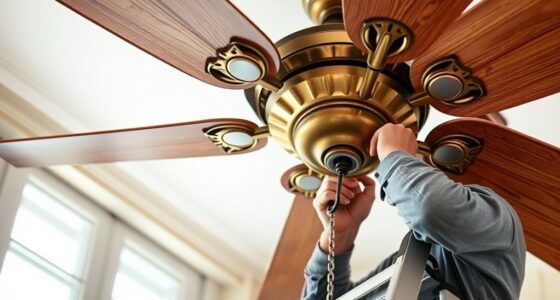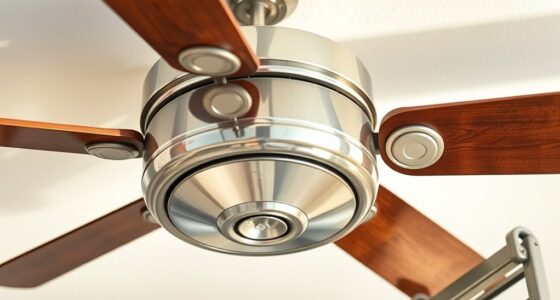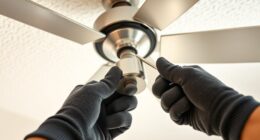To maintain outdoor ceiling fans and enhance weatherproofing, routinely inspect and tighten mounting hardware to prevent wobbling. Clean blades and motor housings with damp, lint-free cloth to eliminate debris that can cause imbalance. Check wiring for corrosion and ensure all connections are waterproof, replacing damaged components promptly. Apply weatherproof sealants like silicone around junction boxes and seals to prevent water ingress. Regularly verify lubrication needs per manufacturer guidelines to reduce friction and extend lifespan. Continuing with these detailed steps will help you maximize your fan’s durability and performance.
Key Takeaways
- Regularly inspect seals, gaskets, and junction boxes for water ingress and reseal with weatherproof sealants.
- Clean blades and motor housing with damp cloth to prevent dust buildup and maintain airflow efficiency.
- Check wiring and electrical connections for corrosion or damage, ensuring they are tight and waterproof.
- Tighten mounting hardware after storms or high winds to prevent wobbling and structural issues.
- Consult manufacturer guidelines for lubrication and apply weather-resistant grease if required.

Have you ever wondered why outdoor ceiling fans require regular maintenance? The answer lies in their exposure to the elements, which accelerates wear and demands specific upkeep to guarantee peak performance and longevity. Weatherproofing doesn’t eliminate the need for routine inspections; instead, it shifts the focus toward identifying vulnerabilities caused by environmental factors such as moisture, dust, and temperature fluctuations. Proper maintenance begins with understanding the fan’s construction—most outdoor models feature corrosion-resistant materials like aluminum or treated steel, but even these can degrade over time without proper care.
Start by shutting off the power supply and safely removing the fan’s housing or blades, if possible. Carefully examine the motor and mounting bracket for signs of corrosion, rust, or loose connections. Moisture intrusion can compromise electrical components, so check for any water ingress around seals, gaskets, or junction boxes. It’s crucial to replace or reseal these components using weatherproof sealants designed for outdoor use, such as silicone-based compounds, to prevent ongoing moisture penetration. Inspect the wiring for fraying, corrosion, or discoloration, indicating potential electrical failure or short circuits. Corrosion on electrical contacts can increase resistance, leading to overheating; replace damaged wiring immediately and ensure all connections are tight and protected by waterproof connectors.
Cleaning the fan’s components is equally critical. Use a damp, lint-free cloth to wipe down blades, motor housing, and mounting hardware, avoiding abrasive cleaners that could damage protective coatings. Dust and debris accumulation on blades not only diminishes airflow efficiency but can cause imbalanced rotation, stressing the motor. For stubborn grime or buildup, a mild soap solution will suffice, but always dry components thoroughly afterward to prevent moisture retention. Pay close attention to the fan’s blades, as warped or chipped blades can cause vibrations and noise, potentially damaging the motor or mounting system over time.
Lubrication is often overlooked but plays an indispensable role in maintaining smooth operation. Many outdoor fans feature sealed or self-lubricating bearings, yet some models require periodic lubrication with weather-resistant grease. Consult the manufacturer’s specifications to determine if lubrication is necessary and follow the recommended procedure precisely. Failing to do so can result in increased friction, overheating, and reduced lifespan. Additionally, check the fan’s mounting hardware periodically—tighten bolts and screws to avoid wobble or imbalance, especially after storms or high winds. Regularly inspecting and maintaining outdoor ceiling fans with these weatherproof tips guarantees they continue functioning efficiently, safely, and reliably despite the challenging outdoor environment. Moreover, utilizing weatherproofing techniques and quality materials can significantly extend the lifespan of your fan and keep it operating at peak performance.
Frequently Asked Questions
Can Outdoor Ceiling Fans Be Left Outside During Winter?
Yes, you can leave outdoor ceiling fans outside during winter if they’re weatherproof and properly maintained. Make certain you have a sealed, rust-resistant motor housing and sealed electrical connections. Regularly clean off debris and check for corrosion. If your fan isn’t rated for winter, it’s best to cover it with a weatherproof cover or remove and store it indoors. Proper winterization prevents damage and extends your fan’s lifespan.
What Type of Paint Is Best for Outdoor Fan Blades?
You should use a high-quality, outdoor-rated acrylic or latex enamel paint on your fan blades. These paints resist moisture, UV rays, and temperature fluctuations, ensuring durability. Choose a paint labeled as “exterior” and suitable for wood, metal, or plastic, depending on your blades’ material. Proper surface preparation, including cleaning and light sanding, enhances adhesion. Apply multiple thin coats, allowing adequate drying time between layers for a long-lasting, weather-resistant finish.
How Often Should I Inspect Outdoor Fan Wiring?
You should inspect outdoor fan wiring at least once a year to guarantee safety and peak performance. Studies show that electrical faults cause nearly 20% of outdoor electrical fires. During inspection, turn off power, check for corrosion, loose connections, or damaged insulation, and tighten any loose fittings. Regular checks prevent hazards and extend your fan’s lifespan. Always use a qualified electrician if you’re unsure or notice issues.
Are There Specific Outdoor Fan Models Resistant to Saltwater?
Yes, some outdoor fan models are designed to resist saltwater corrosion. Look for fans labeled as marine-grade or with corrosion-resistant coatings, such as those made from stainless steel, aluminum, or treated plastics. Brands like Hunter, Minka-Aire, and Casa Vieja offer models with sealed electrical components and corrosion-resistant finishes. Always verify the product specifications for saltwater resistance before purchasing, and consider additional protective measures like covers or enclosures for prolonged exposure.
Can Outdoor Fans Be Professionally Waterproofed?
Yes, outdoor fans can be professionally waterproofed. Think of it as giving your fan a custom suit tailored for harsh weather. Experts apply specialized sealants, waterproof enclosures, and corrosion-resistant coatings to protect electrical components and mechanical parts. This process guarantees durability against moisture, salt spray, and rain. However, it’s essential to use certified waterproofing services and follow manufacturer guidelines to maintain safety and performance, extending your fan’s lifespan considerably.
Conclusion
By regularly inspecting and cleaning your outdoor ceiling fan, you guarantee it withstands the elements like a sturdy ship braving rough seas. Applying weatherproof coatings and tightening components keeps it resilient against rain, sun, and wind. Think of your fan as an essential part of your outdoor sanctuary—meticulous maintenance transforms it from vulnerable to enduring. With each careful step, you’re safeguarding your investment, allowing cool breezes to flow freely, no matter what weather challenges come your way.








